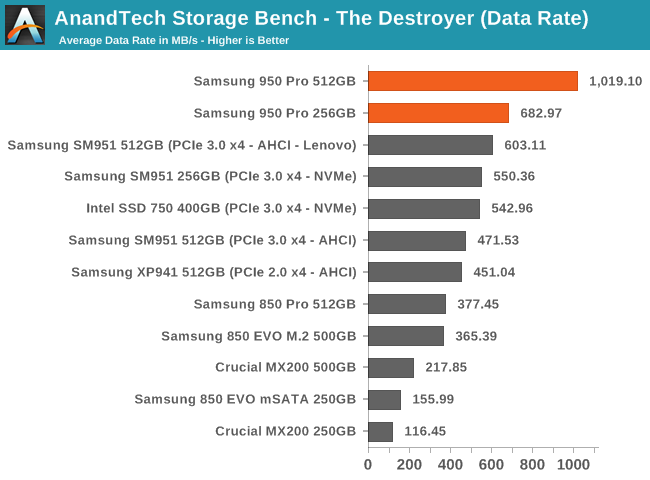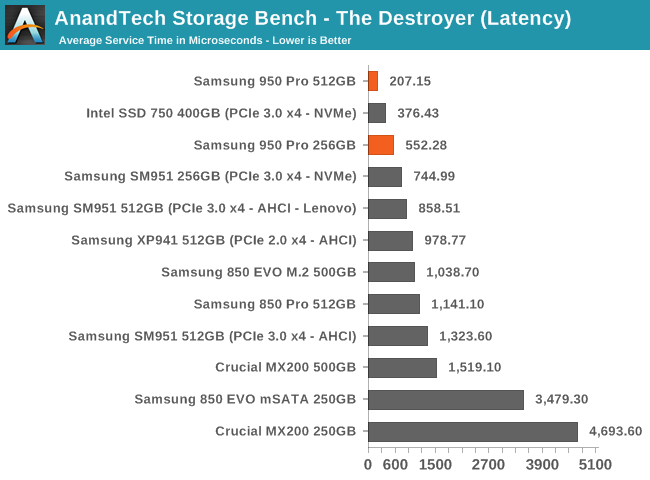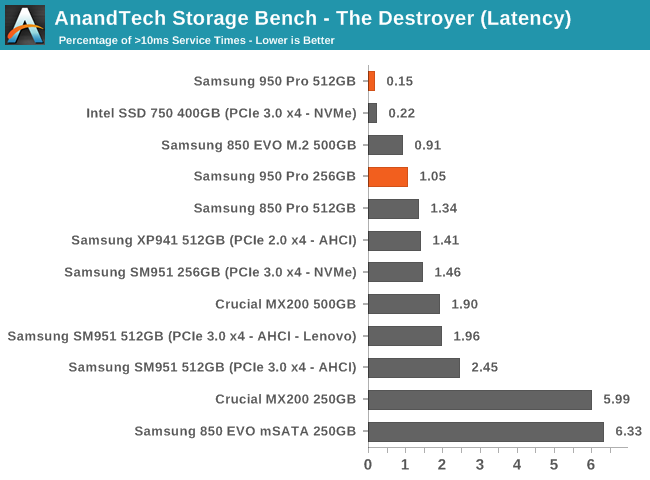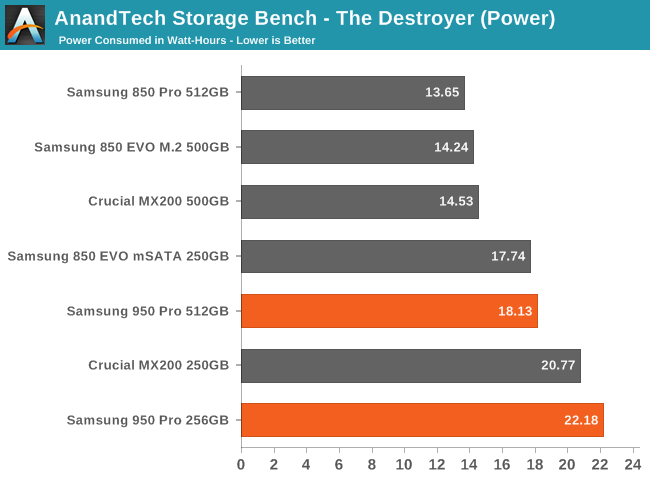The Samsung 950 Pro PCIe SSD Review (256GB and 512GB)
by Billy Tallis on October 22, 2015 10:55 AM ESTAnandTech Storage Bench - The Destroyer
The Destroyer is an extremely long test replicating the access patterns of heavy desktop usage. A detailed breakdown can be found in this review. Like real-world usage and unlike our Iometer tests, the drives do get the occasional break that allows for some background garbage collection and flushing caches, but those idle times are limited to 25ms so that it doesn't take all week to run the test.
We quantify performance on this test by reporting the drive's average data throughput, a few data points about its latency, and the total energy used by the drive over the course of the test.

Both 950 Pros deliver great performance on the destroyer, but the 512GB is outstanding. Clearly the more bursty nature of this test allows the drive to avoid any thermal throttling and deliver the high peak speeds that the PCIe interface is supposed to enable.

The NVMe drives deliver the lowest average service times, but the other PCIe drives are close behind. If there were any moments of thermal throttling like we saw with the performance consistency test, they would greatly inflate the average service time.

The very small number of performance outliers on this test is a good indicator that these drives don't sieze up under the pressure of an interactive workload.

When looking at the more strict latency threshold of 10ms, the 256GB 950 Pro is not significantly better than the good SATA drives, but the 512GB has extremely good control over latency.

Energy usage is not competitive with the high-performance SATA drives. As demanding as it is, The Destroyer still has opportunities for drives to scale back power consumption but the 950 Pro can't do that on our testbed.










142 Comments
View All Comments
Der2 - Thursday, October 22, 2015 - link
Wow. The 950. A BEAST in the performance SHEETS.ddriver - Thursday, October 22, 2015 - link
Sequential performance is very good, but I wonder how come random access shows to significant improvements.dsumanik - Thursday, October 22, 2015 - link
Your system is only as fast as the slowest component.Honestly, ever since the original x-25 the only performance metric I've found to have a real world impact on system performance (aside from large file transfers) with regards to boot times, games, and applications is the random write speed of a drive.
If a drive has solid sustained random write speed, your system will seem to be much more responsive in most of my usage scenarios.
950 pro kind of failed to impress in this dept as far as I'm concerned. While i am glad to see the technology moving in this direction, I was really looking for a generational leap here with this product, which didn't seem to happen, at least not across the board.
Unfortunately I think i will hold off on any purchases until i see the technology mature another generation or two, but hey if you are a water-cooling company, there is a market opportunity for you here.
Looks like until some further die shrinks happen nvme is going to be HOT.
AnnonymousCoward - Thursday, October 22, 2015 - link
> Your system is only as fast as the slowest component.Uhh no. Each component serves a different purpose.
cdillon - Thursday, October 22, 2015 - link
>> > Your system is only as fast as the slowest component.>Uhh no. Each component serves a different purpose.
Memory, CPU, and I/O resources need to be balanced if you want to reach maximum utilization for a given workload. See "Amdahl's Law". Saying that it's "only as fast as the slowest component" may be a gross over-simplification, but it's not entirely wrong.
xenol - Wednesday, November 4, 2015 - link
It still highly depends on the application. If my workload is purely CPU based, then all I have to do is get the best CPU.I mean, for a jack-of-all-trades computer, sure. But I find that sort of computer silly.
xype - Monday, October 26, 2015 - link
Your response makes no sense.III-V - Thursday, October 22, 2015 - link
I find it odd that random access and IOPS haven't improved. Power consumption has gone up too.I'm excited for PCIe and NVMe going mainstream, but I'm concerned the kinks haven't quite been ironed out yet. Still, at the end of the day, if I were building a computer today with all new parts, this would surely be what I'd put in it. Er, well maybe -- Samsung's reliability hasn't been great as of late.
Solandri - Thursday, October 22, 2015 - link
SSD speed increases come mostly from increased parallelism. You divide up the the 10 MB file into 32 chunks and write them simultaneously, instead of 16 chunks.Random access benchmarks are typically done with the smallest possible chunk (4k) thus eliminating any benefits from parallel processing. The Anandtech benchmarks are a bit deceptive because they average QD=1, 2, 4 (queue depth of 1, 2, and 4 parallel data read/writes). But at least the graphs show the speed at each QD. You can see the 4k random read speed at QD=1 is the same as most SATA SSDs.
It's interesting the 4k random write speeds have improved substantially (30 MB/s read, 70 MB/s write is typical in SATA SSDs). I'd be interested in an in-depth Anandtech feature delving into why reads seem to be stuck at below 50 MB/s, while writes are approaching 200 MB/s. Is there a RAM write-cache on the SSD and the drive is "cheating" by reporting the data as written when it's only been queued in the cache? Whereas reads still have to wait for completion of the measurement of the voltage on the individual NAND cells?
ddriver - Thursday, October 22, 2015 - link
It is likely samsung is holding random access back artificially, so that they don't cannibalize their enterprise market. A simple software change, a rebrand and you can sell the same hardware at much higher profit margins.